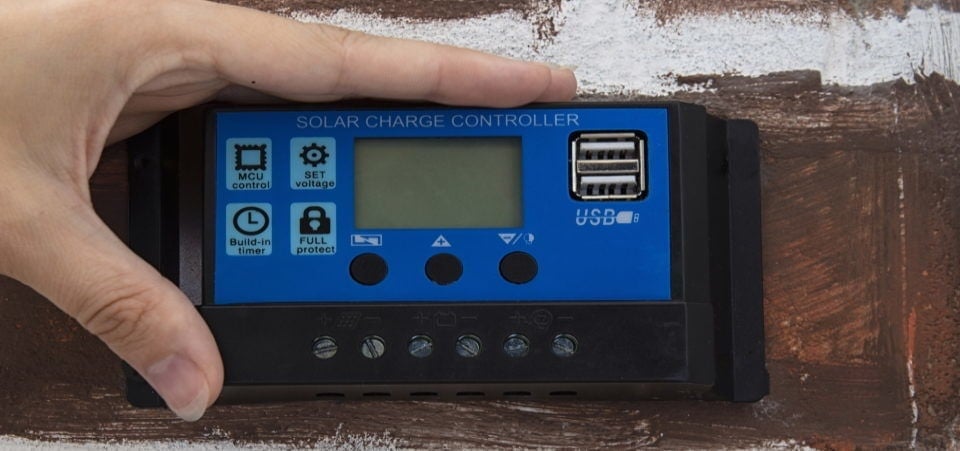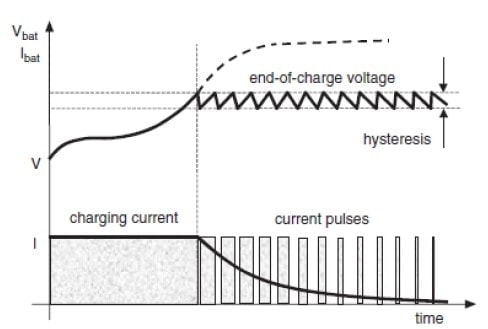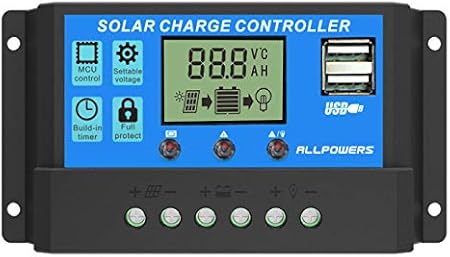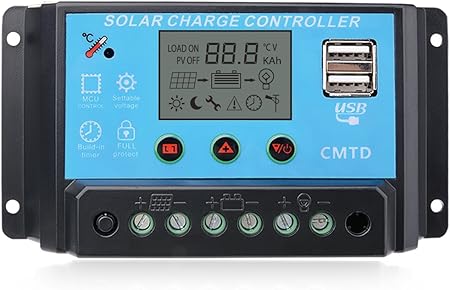
10 Best Solar Charge Controllers in [current_year] (Review)
A charge controller device is essential to prevent battery damage. It stands in-between your energy generation source, the solar panels, the energy storage component (battery), and the final load — guaranteeing correct and full control of energy flows and system protection.
As important as it is, comparing different charge controllers can be a little confusing. That’s why the following list presents the best solar charge controllers in [current_year].
Offering a wide variety of prices and characteristics, some of these charge controllers shine through their technologically advanced features. Others are known for their great power capacity or purely through their simplistic and easy-to-use design.
No matter what you’re looking for, one of these controllers is the perfect option for your RV, boat, or residential application.
Written by qualified solar engineer Carlos. Last updated:
Page Contents
Short on Time? See our Top Rated Products From 3 Categories

Victron SmartSolar MPPT
- Victron Remote Management Portal
- Complete remote configuration via smartphone possible
- Max PV input open voltage of 100Vdc
Where To Buy

Renogy Wanderer
- Preprogrammed parameters according to battery type
- 4-stage PWM charging process
- Max input PV voltage of 50Vdc

Outback Flexmax 80
- Remote temperature sensor
- Voltage step-down capability allowing a PV open-circuit voltage up to 150 VDC
- Built-in 128 days of data logging
Where To Buy
The Best Solar Charge Controllers

1. Renogy Wanderer Solar Charge Controller
Key Features:
- Preprogrammed parameters according to battery type.
- 4-stage PWM charging process.
- Max input PV voltage of 50Vdc.
Key Specifications:
- RS232 port for communication with Bluetooth T-1 module.
- Two USB 5V, 2 amps ports.
- Battery Voltage 12/24V
The Renogy Wanderer is an advanced charge controller proper for off-grid solar applications. Integrating highly efficient Pulse Width Modulation (PWM) charging, that can be set for Lithium, AGM, gel or flooded batteries, it increases battery life and improves system performance.
It can be used for 12 or 24-volt battery banks with a charging capacity of 10 amps, perfect for the integration with a set of portable solar panels.
The controller is embedded with self-diagnostics and electronic protection functions such as overcharging, overcurrent, short circuit, reverse current and reverse polarity, which prevents damage from installation mistakes or system faults.
The PWM algorithm has a 4-stage battery charging process for a rapid, efficient and safe battery charging. They include Bulk, Boost, Float, and Equalization charge.
The Equalization is carried out for AGM and flooded batteries every 28 days, and it intentionally overcharges the battery for a controlled period. These batteries benefit from periodic equalizing.
2. Victron SmartSolar MPPT 100/20 Solar Charge Controller

Key Features:
- Victron Remote Management Portal.
- Complete remote configuration via smartphone possible.
- Max PV input open voltage of 100Vdc.
Key Specifications:
- SBuilt-in Bluetooth.
- Rated charge current 20A.
- Battery Voltage 12/24V.
Where To Buy
The Victron SmartSolar MPPT 100/20 model is made by the well-known high-quality manufacturer based in the Netherlands, Victron Energy.
With an intelligent and lightning-quick system, this charge controller for solar panels is a great choice for those unfamiliar or new to solar system installation.
The main attraction feature, the wireless Bluetooth management system, puts this device on the top of the list, allowing remote monitoring and setting updates trough smartphones or Victron products. The MPPT control is configured for a three-step charging process to extend batteries life, though it can be programmed for equalization on lead batteries.
Built-in LED indicator lights offer a real-time view of the battery charging process stage, and allow to diagnose system fault situations with the combination of ON, OFF and blinking state of the LEDs.
The charger is upgradable by purchasing Victron add-ons such as the battery monitor BMV-700 series, which provides status information like voltage, current, watts and more.
3. Outback Flexmax 80 Solar Charge Controller

Key Features:
- Remote temperature sensor.
- Voltage step-down capability allowing a PV open-circuit voltage up to 150 VDC.
- Built-in 128 days of data logging.
Key Specifications:
- RJ45 modular connector Cat 5 cable 8 wire for the remote interface.
- Rated Output Current 80A.
- Battery Voltage: 12/24/36/48 V.
Where To Buy
The Outback Flexmax 80 charge controller uses continuous Maximum Power Point Tracking (MPPT), a tracking algorithm that seeks out the maximum power available from a PV array and uses it to fully recharge the batteries, allowing to extract the maximum amount of energy produced by solar panels.
Meanwhile, Outback’s FLEXmax 80 solar power controller, works at fully spec features thanks to its smart refrigeration system that allows it to work at 80 amps at a maximum temperature of 104 °F (40 °C). It also works at a wide variety of battery nominal voltages thanks to its great step-down voltage capacity that allows a higher PV array voltage configuration.
The FLEXmax system comes with a backlit LCD screen with an 80-character display which shows the system state. The display helps to set the manual or auto-equalize cycle for the batteries, and with the help of the communication components (MATE3) gives access to the last 128 days of operational data for review.
4. WindyNation P30L
Key Features:
- Electronic protection against overload, short-circuit, reverse polarity.
- Compatible with AGM, lead acid, GEL type batteries.
- Optional temperature compensation.
Key Specifications:
- Maximum Solar Input Voltage: 50V.
- Rated Output Current 20A.
- Battery Voltage 12/24V.
Where To Buy
Solar Charge Controllers is a premium solar PWM charge controller that features a complete digital visualization of system most important information that works as a user-system interface that allows the configuration of the solar driver.
Ideal for 12 and 24 volts batteries, an automatic detect function identifies the battery voltage upon initial connection and offers up to 30 amp charging current. Built-in circuit protection includes overload, short circuit, reverse polarity, lighting/source, PV panel reverse-current, overcharging, and discharging protection.
The controller includes a battery temperature sensor (BTS) that assures temperature compensation of the charge voltage enhancing battery performance and life and decreasing battery maintenance.
The enclosure is made out of durable plastic with visual LCD graphic symbols to provide status indications of charge, battery status, and system faults.
P30L fits as the perfect model for the well-known solar kit for an RV of WindyNation.
5. Epever MPPT
Key Features:
- Multiple load controls.
- PC and mobile APP software for remote communication.
- Ultra-fast MPPT control algorithm.
Key Specifications:
- RS-485 and Modbus communication bus and protocol.
- Rated charge current 20A.
- Battery Voltage 12/24V.
Where To Buy
The Epever MPPT Tracer AN series is an advanced solar charge controller MPPT algorithm-based. It is located at the top of the list of MPPT charge controllers due to its cost-effective capability, reaching a peak conversion efficiency of up to 98%.
Featuring a multi-function LCD display, it is also user-programmable for several battery types: Sealed, GEL, AGM, flooded, liFEPO4 or Li(NiCoMn). It also features an automatic battery voltage recognition.
Moreover, its RS-485 communication bus interface and Modbus communication protocol, permits mobile APP or PC software parameters setting and monitoring, and meets various communication requirements for different situations.
The included MT-50 remote meter displays real-time operating data and fault of the system, and the remote temperature sensor allows temperature compensation according to battery temperature.
The Tracer 2210AN is rated for a maximum open-circuit input voltage from the panels of 100 volts, allowing up to 390W on 12 volts systems and 780W on 24 volts of input power.
Multiple load work modes ensure complete control over the batteries charge and discharge process.
6. Renogy Adventurer
Key Features:
- Programmable Lithium charging voltage.
- PWM 4-stage algorithm.
- Optional temperature compensation.
Key Specifications:
- RS232 Communication Port with Bluetooth.
- Rated charge current 30A.
- Battery Voltage 12/24V.
Where To Buy
The Adventurer-Li made by Renogy Adventurer is ideal for off-grid applications on 12V and 24V systems. Thanks to its programmable Lithium charging voltage, the 30amp PWM model is now capable of charging most Lithium batteries available on the market.
Unique in its form, the Adventurer-Li is specifically designed as an RV solar charge controller allowing an aesthetically clean flush mounting on walls thanks to the included attachment.
The controller includes a remote temperature sensor (TS-R) for accurate temperature compensation and a remote battery voltage sensor (RBVS) for a proper measure of battery terminals.
The RS232 connects and communicates the controller with the Renogy BT-1 Bluetooth module. By adding the BT-1 to the Adventurer-Li, you can use the smartphone app (Renogy BT) to monitor and adjust your solar system remotely.
Just as other Renogy PWM controllers, the Adventurer uses a PWM 4-stage algorithm to increase battery longevity accordingly to battery type AGM, Gel, Flooded or lithium.
7. ALLPOWERS 20A
Key Features:
- 3-stage charge and 4 stage PWM control.
- Multiple protection features.
- Small size, perfect for RV, off-grid, or remote applications.
Key Specifications:
- Two USB 5V, 3 amps ports.
- Rated charge current 20A.
- Battery Voltage 12/24V.
Where To Buy
This solar battery charge controller from ALLPOWERS 20A is good quality, low price product that any enthusiast of solar should take into account.
The ALLPOWERS controller is a lead-acid battery charger capable of handling Flooded, AGM or GEL cells. It is intended for indoor use and is able to work within a temperature range of -35°C to +60°C while counting with multiple electric circuit protection features.
The adjustable power rate with dual USB, 5 volts, 3 amps ports, offers a great option for phone charging or home applications. Equipped with an industrial-grade STM 8 microprocessor, the 3-stage (Bulk, ABS, and float) charge management, and 4-stage PWM charge of the battery assures its protection and lifespan.
Moreover, the easy to use LCD screen display clearly indicates the status and data of the system. It can be conveniently switched in-between modes and offer an easy parameter configuration.
8. HQST 40
Key Features:
- Max PV input power: 400W (12V), 800W (24V).
- Light control mode for lighting appliances.
- Remote monitoring and control are possible.
Key Specifications:
- RJ12 communication port for RS232 protocol.
- Rated charge current 30A.
- Battery Voltage 12/24V.
Where To Buy
High-Quality Solar Technologies (HQST) offers one of the best PWM models of the market. The HQST 40 is an intelligent and multifunctional solar charge controller with a dual USB port designed for modern electronics, and compatible with an HQST set of portable panels.
The controller microprocessor automatically detects 12 or 24-volts system voltages. Besides, with the help of temperature compensation, charging parameters can also be automatically adjusted.
It also integrates an LCD screen for human-machine interface with keys that facilitate the setting of a wide range of load working modes that enable its usage for multiple types of applications. All of the charging and controlling parameters can be reset to satisfy the user’s particular needs.
Many electrical protection features complete the safety of the whole system, securing the battery lifespan of lead-acid and lithium batteries and protecting them against installation errors as well.
An optional communication function provides an RJ12 data port (output of TTL232 level or Bluetooth signals), with the data adopting the standard Modbus protocol which can be used together with our upper computer monitoring software or mobile phone app.
9. GHB 20A
Key Features:
- 12 volts automatic system recognition.
- PWM control for system energy efficiency.
- Overload, short-circuit, lightning and under-voltage protection.
Key Specifications:
- Two, USB 5V, 3 amps ports.
- Rated charge current: 20A.
- Battery Voltage 12/24V.
Where To Buy
GHB 20A is a lead-acid battery solar charge controller that offers a clear and modern LCD visualization screen.
This completely automatic charger works with any 12 volts system while offering many electrical protection features including reverse polarity protection. The PWM control enhances system efficiency and ensures the lifespan of the battery.
Its hardware comes with two USB 5 volts/3 amps ports, and a dual 12 volts output port to power DC lamps or works as a phone charger. It also allows the possibility of integrating temperature compensation with a temperature sensor connected to the batteries.
The easy to install enclosure facilitates the setup and operation of the controller.
10. PowMr 60A
Key Features:
- Works at 12 and 24-volts system.
- Small size, perfect for RV, off-grid, or remote applications.
- Multiple protection features.
Key Specifications:
- Two USB 5V, 2 amps ports.
- Rated charge current 20A.
- Battery Voltage 12/24V
Where To Buy
Sunix charger is another great PWM solar charge controller option in the market due to its low price.
PoweMr 60A, can handle up to 20 amps of charge and discharge current and can work at 12 or 24-volt battery pack systems, with an integrated auto-switch feature that detects the battery nominal voltage. As for the input, the charger can handle up to 50 volts of working voltage from the PV array.
It has been designed for small applications but has a powerful design that offers over-load, short-circuit, lightning, under-voltage, over-discharge and battery reverse polarity protection.
The LCD screen offers the end-user a complete visualization of the system status and makes it easy to set the working mode of the battery discharge and load feeding process.
How to Choose a Solar Charge Controller – 3 Things to Think About
Battery voltage and type
The first thing to look out for is whether the controller can charge up your battery properly. All batteries require a different type of charging process. The stages of the charging process can differ from one to another, or they can also differ in how the process is made on each stage in the first place.
Also, you need to check to see if the charger can manage your nominal battery voltage. The common or commercial standard battery bank nominal voltages are 12, 24, or 48 volts.
Usually, all brand product series offer variations of the same controller depending on the nominal voltage of the battery to manage.
PV array to feed the charger
The solar array will be the life of your off-grid solar panel controller, therefore it has to be able to interact with the controller. To do so, the power and current capacity of the array cannot surpass the maximum input rating of the controller.
Budget
Are you short on budget? Are your energy needs minimal? Then you should go for a PWM controller. This type of controller will generally be the ideal option for small solar systems to protect and safely charge your battery.
Now, if you want to get the most power out of your PV array, an MPPT controller can be your solution. They can typically charge a battery-based system with lighting, cooking and heating appliances since they are made for higher energy needs when harvesting the most out of your solar panels. These types of controllers are mainly used in residential, commercial, or industrial applications, although it can also be used for smaller applications.
Features to Look for When Buying a Solar Charge Controller for an RV

Take into account that the more features a charge controller has, the more you are likely to spend on it.
Today’s market offers a number of different features on charge controllers for an RV. Once you figure out the charging parameters that you need for your specific PV array and battery (generally available in the user manual or datasheet of your battery and solar panel), you can look for size, protection or weight specifications.
Many care about the aesthetics of the controller once it is installed. There are surface, flush, or mountings that may be what you are looking for.
An important feature that may add value for your RV solar system is the possibility of monitoring and check energy balances. Make sure that you can check system status or log into the register system data of your controller.
How Many Solar Panels Can You Connect to One Controller?
Sizing a solar array for a charge controller depends on three things.
- Open circuit Voltage (Voc): Which is the maximum unloaded voltage generated from your PV array, this voltage should never exceed the maximum input voltage of the controller under any situation.
- Maximum-Operating Voltage (Vmp): This is the operating voltage for the PV arrays at which panels generate the most wattage. It is recommended for the Vmp to be 12 or 24 volts higher than the nominal voltage of the battery.
- Maximum PV array power/current: Many controllers do not specify the maximum rated power, but by sizing the PV array according to voltage and maximum input current constraints you can guarantee that the controller can handle your panels output power.
Many high-end controllers, such as the MPPT ones, offer an extra PV array power recommendation because they can handle much higher Vmp voltages than the nominal voltage of the battery connected to them thanks to the step-down capability.
Thus, the number of solar panels that can you connect to your controller depends on your array open-circuit and operating voltages, and the maximum operating current.
As an example, if your controller has a maximum power rating of 250W and you want to charge a 12 volts battery, your PV array should have a Vmp close to 18-20 volts and should exceed a maximum current output of around 14 amps (250W/18V = ~13.88A, which should be within current input capacity of the controller).
What is the difference between PWM and MPPT Solar Charge Controllers?
A pulse width modulation (PWM) charge controller can be understood as a “switch” in between the panels and the battery.
- When the battery is at its lowest state-of-charge, the “switch” changes to ON mode to connect the power output of the panels to the batteries.
- Once the battery has reached a certain voltage, it stabilizes and the current flowing into the battery needs to be controlled, at this stage the controller “switches” in-between ON and OFF to hold the battery voltage at the given voltage. This iterative process (which can be seen in the figure below) has the shape of multiple pulses which is why it is known as PWM.
- The switch is OFF at the end of the charging process.
- And again the switch flicks in-between ON and OFF to maintain the float voltage of the battery.

While an MPPT controller is more of a “smart DC-DC” converter.
The controller lowers the voltage of the panels to match the batteries specified voltage while increasing the current that flows into the batteries at the same ratio to obtain an equal amount of power to the one injected by the PV modules at their maximum power point. The controller tracks the Maximum Power Point of operation of the panel (that varies during the day) and adjusts the DC-DC converter output accordingly.
Therefore, the MPPT controller output power is much higher than the PWM option.
How to Understand the Solar Charge Controller Ratings
To determine the charge controller model that you need for your specific application, you need to understand the datasheet of one of these devices. Depending on the brand, you will find different parameters or ratings, but to size your PV system the most important factors that you must look into will be:
- Nominal Battery System Voltage: Represents the nominal battery bank voltage which is generally established in 12V/24V/48V or 60V. Some battery banks can have larger system voltages, but these are intended for industrial applications.
- Maximum Continuous Output Current: Related to the maximum current that the device can provide to charge the battery bank.
- Maximum Input Current: Associated with the maximum solar panel array output (short-circuit condition) which should be lower than the input limit of the charge controller.
- Operating Input Voltage: Voltages vary across the day according to temperature variations. In order to work properly, the solar array voltage variations must be located within the pre-established limits of the controller.
- Maximum PV System Voltage: Maximum voltage under coldest conditions that are allowed on the PV array.
- Maximum Array STC Nameplate: Maximum STC power allowed in the PV system.
References
- Solar charge controller advice – SolarMonsters.
- Learn, download – Renogy.
- Charge Controllers – WindyNation.
- Products overview – IAllPowers.
We hope you liked this article. Please rate it or leave us a comment.
Average rating 4.3 / 5. Vote count: 7
No votes so far! Be the first to rate this post.




















